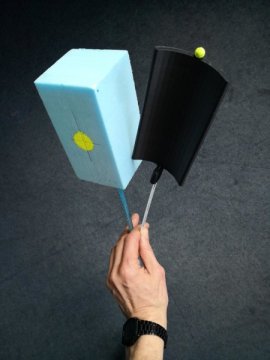[ad_1]
Researchers at the University of Warwick have been inspired by the unique movement of trembling aspen leaves, to devise an energy harvesting mechanism that could power weather sensors in hostile environments and could even be a back-up energy supply that could save and extend the life of future Mars rovers.
University of Warwick third year engineering undergraduates have in recent years been set the task of the examining the puzzle of why Aspen leaves quiver in the presence of a slightest breeze. University of Warwick Engineering researchers Sam Tucker Harvey, Dr Igor A. Khovanov, and Dr Petr Denissenko were inspired to look more closely at this task they were annually setting for their students and to take the phenomenon one step further.
They decided to investigate whether the underlying mechanisms that produce the low wind speed quiver in Aspen leaves could efficiently and effectively generate electrical power, simply by exploiting the wind generated mechanical movement of a device modelled on the leaf. They have today 18th March 2019 published the answer to that question as a paper entitled “A Galloping Energy Harvester with Flow Attachment” in Applied Physics Letters and the answer is a resounding yes.
University of Warwick PhD engineering researcher Sam Tucker Harvey, the lead author on the paper, said:
“What’s most appealing about this mechanism is that it provides a mechanical means of generating power without the use of bearings, which can cease to work in environments with extreme cold, heat, dust or sand. While the amount of potential power that could be generated is small, it would be more than enough to power autonomous electrical devices, such as those in wireless sensor networks. These networks could be utilised for applications such as providing automated weather sensing in remote and extreme environments.”
Dr Petr Denissenko further noted that one future application could be as a backup power supply for future Mars landers and rovers.
“The performance of the Mars rover Opportunity far exceeded its designers’ wildest dreams but even its hard working solar panels were probably eventually overcome by a planetary-scale dust storm. If we could equip future rovers with a backup mechanical energy harvester based on this technology, it may further the lives of the next generation of Mars rovers and landers.”
The key to Aspen leaves’ low wind but large amplitude quiver isn’t just the shape the leaf but more importantly relates to the effectively flat shape of the stem.
The University of Warwick researchers used mathematical modelling to come up with a mechanical equivalent of the leaf. They then used a low speed wind tunnel to test a device with a cantilever beam like the flat stem of the Aspen leaf, and a curved blade tip with a circular arc cross section acting like the main leaf.
The blade was then oriented perpendicular to the flow direction, which allows the harvester to produce self-sustained oscillations at uncharacteristically low wind speeds like the aspen leaf. The tests showed that the air flow becomes attached to the rear face of the blade when the blade’s velocity becomes high enough, hence acting more similarly to an aerofoil rather than to the bluff bodies which have typically been studied in the context of wind energy harvesting.
In nature, the propensity of a leaf to quiver is also enhanced by the thin stem’s tendency to twist in the wind in two different directions. However, the researchers modelling and testing found that they did not need to replicate the additional complexity of a further degree of movement in their mechanical model. Simply replicating the basic properties of the flat stem in as a cantilever beam and curved blade tip with a circular arc cross section acting like the main leaf was enough to create sufficient mechanical movement to harvest power.
The researchers will next examine which mechanical movement based power generating technologies would best be able to exploit this device and how they device could best be deployed in arrays.
Story Source:
Materials provided by University of Warwick. Note: Content may be edited for style and length.
[ad_2]















